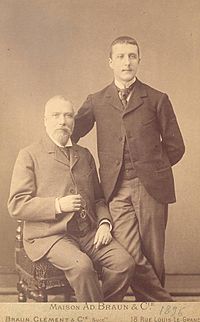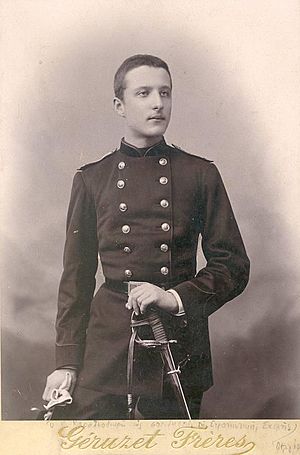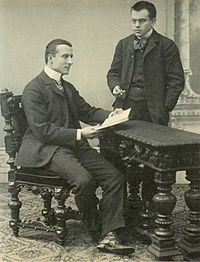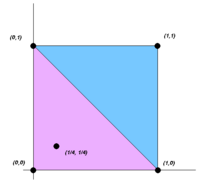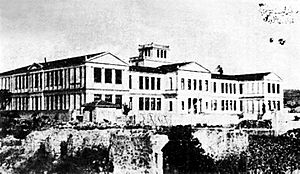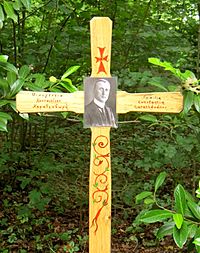Constantin Carathéodory facts for kids
Quick facts for kids
Constantin Carathéodory
|
|
|---|---|
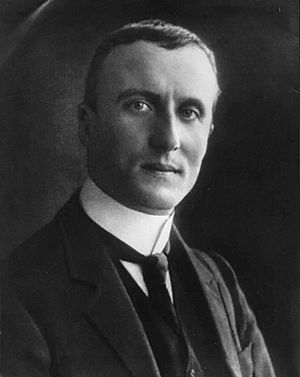
Constantin Carathéodory
|
|
| Born | 13 September 1873 |
| Died | 2 February 1950 (aged 76) |
| Nationality | Greek |
| Alma mater | University of Berlin University of Göttingen |
| Known for | Carathéodory conjecture Carathéodory function Carathéodory metric Carathéodory theorems Carathéodory's criterion Carathéodory's lemma Carathéodory's positivity criterion for holomorphic functions Carathéodory's principle Carnot–Carathéodory metric Adiabatic accessibility Cyclic polytope Prime end General theory of outer measures Axiomatic formulation of thermodynamics |
| Scientific career | |
| Fields | Calculus of variations Real analysis Complex analysis Measure theory |
| Institutions |
|
| Doctoral advisor | Hermann Minkowski |
| Doctoral students | Paul Finsler Hans Rademacher Georg Aumann Hermann Boerner Ernst Peschl Wladimir Seidel Nazım Terzioğlu |
| Signature | |
Constantin Carathéodory (Greek: Κωνσταντίνος Καραθεοδωρή, romanized: Konstantinos Karatheodori; 13 September 1873 – 2 February 1950) was a Greek mathematician. He spent most of his career working in Germany. He made many important discoveries in different areas of mathematics. These included real and complex analysis, the calculus of variations, and measure theory. He also created a new way to explain the laws of thermodynamics, which is about heat and energy. Carathéodory is seen as one of the most important mathematicians of his time. Many consider him the most famous Greek mathematician since ancient times.
Contents
Early Life and Education
Constantin Carathéodory was born in 1873 in Berlin, Germany. His parents were Greek. He grew up in Brussels, Belgium. His father, Stephanos, was a lawyer. He worked as an ambassador for the Ottoman Empire in different cities. These included Belgium, St. Petersburg, and Berlin. Constantin's mother, Despina, was from the island of Chios.
The Carathéodory family was well-known in Constantinople. Many family members held important government jobs. In 1874–75, Constantin's family lived in Constantinople. His father was on leave from his job. In 1875, they moved to Brussels. His father became the Ottoman Ambassador there. Constantin's younger sister, Julia, was born in Brussels.
A sad year for the family was 1879. Constantin's grandfather passed away. Even more sadly, his mother, Despina, died from pneumonia in Cannes. Constantin's grandmother then helped raise him and Julia. They had a German maid who taught the children German. Constantin already spoke French and Greek very well.
Constantin started school in 1881 at a private school. After two years, he left. He then visited Berlin with his father. He also spent winters in Italy. In 1885, he returned to Brussels. He went to a grammar school. Here, he first became interested in mathematics. In 1886, he joined Athénée Royal d'Ixelles high school. He studied there until 1891. During this time, he won a prize twice. He was named the best mathematics student in Belgium.
After high school, Carathéodory trained to be a military engineer. He attended the École Militaire de Belgique from 1891 to 1895. He also studied at the École d'Application. In 1897, a war started between the Ottoman Empire and Greece. This was hard for Carathéodory. He supported Greece, but his father worked for the Ottoman government.
Because he was a trained engineer, he got a job. He worked for the British colonial service in Egypt. He helped build the Assiut dam until April 1900. When floods stopped construction, he studied mathematics. He read textbooks like Jordan's Cours d'Analyse. He also visited the Cheops pyramid. He took measurements and published them in 1901. That same year, he published a book about Egypt. It had lots of information about the country's history and geography.
University Career
Carathéodory was a brilliant student. He studied engineering in Belgium at the Royal Military Academy.
Academic Journey
- 1900: He began studying at the University of Berlin.
- 1902: He finished his studies at the University of Göttingen. He earned his Ph.D. in 1904 and became a lecturer in 1905.
- 1908: He became a lecturer at the Bonn.
- 1909: He became a full professor at the Hannover Technical High School.
- 1910: He became a full professor at the Breslau Technical High School.
- 1913: He became a professor at the University of Göttingen.
- 1919: He became a professor at the University of Berlin.
- 1919: He was chosen to join the Prussian Academy of Science.
- 1920: He became the University Dean at the Ionian University of Smyrna.
- 1922: He became a professor at the University of Athens.
- 1922: He also became a professor at the Athens Polytechnic.
- 1924: He became a professor at the University of Munich.
- 1938: He retired from his professorship. He continued his work at the Bavarian Academy of Science.
Students and Colleagues
Carathéodory guided about 20 students for their doctoral degrees. Two of his notable students were Hans Rademacher, known for analysis and number theory, and Paul Finsler, who created Finsler space.
He had many important contacts in Germany. These included famous mathematicians like Hermann Minkowski, David Hilbert, Felix Klein, and Albert Einstein. During World War II, his close friends at the Bavarian Academy of Sciences were Perron and Tietze.
Einstein, who was working on his theory of relativity, asked Carathéodory for help. He wanted to understand certain math equations better. Einstein found Carathéodory's explanations "beautiful." He even suggested they be published.
Carathéodory also stayed connected with Greek universities. He helped reorganize them. A close friend was Nicolaos Kritikos. He had attended Carathéodory's lectures. They worked together to help Greek topologist Christos Papakyriakopoulos get his doctorate. One of Carathéodory's students in Athens was Evangelos Stamatis. He later became a well-known scholar of ancient Greek mathematics.
Important Discoveries
Carathéodory made many important contributions to mathematics.
Calculus of Variations
In his Ph.D. work, Carathéodory explored how to extend solutions in math problems. He also studied problems about finding the shortest or longest paths. His method for finding solutions is called Carathéodory's method of equivalent variational problems. It is also known as the royal road to the calculus of variations. This method shows the link between the calculus of variations and partial differential equations. It helps find solutions quickly. His work in this area is now used in optimal control and dynamic programming.
Convex Geometry
Carathéodory's theorem in geometry is about shapes. It says that if a point is inside a shape, you can find a small number of points from the shape's edge that also "contain" that point. He also proposed the Carathéodory conjecture. This idea suggests that a closed curved surface has at least two special points called umbilic points. This conjecture is still being studied by mathematicians today.
Measure Theory
He is known for the Carathéodory extension theorem. This is a key idea in modern measure theory. Measure theory helps mathematicians define the "size" or "volume" of sets of numbers.
Thermodynamics
Carathéodory was interested in thermodynamics since his time in Belgium. In 1909, he published a major work. He explained the Second law of thermodynamics using only mathematical rules. This was a new way to understand how heat and energy work. His ideas caught the attention of top physicists like Max Planck and Max Born.
He simplified basic ideas. For example, "heat" was not a main concept but something that came from other ideas. He explained that if you can't reach certain states of energy, it means there is something called entropy. He also created the term adiabatic accessibility.
Optics
Carathéodory's work in optics (the study of light) is connected to his work in calculus. In 1926, he proved that no system of lenses or mirrors can avoid problems with light, except for simple flat mirrors. He also developed the theory for the Schmidt telescope. In his book Geometrische Optik (1937), he showed how different principles of light, like Huygens' and Fermat's, are related.
Historical Work
During World War II, Carathéodory worked on editing the complete works of Leonhard Euler. These volumes focused on the calculus of variations. They were published in 1946.
The University of Smyrna
At that time, Athens was the main educational center in the region. It couldn't meet the growing need for education in the eastern Aegean Sea and the Balkans. Constantin Carathéodory, then a professor in Berlin, suggested a new university. He thought about Thessaloniki, Chios, and Smyrna as possible locations.
In 1919, the Greek Prime Minister invited him to create a plan. Carathéodory proposed a new university in Smyrna, Asia Minor. It was to be called the Ionian University of Smyrna. In 1920, Carathéodory became the Dean. He worked hard to set up the university. He traveled around Europe to buy books and equipment.
However, the university never opened to students. This was due to the War in Asia Minor. The war ended with the Great Fire of Smyrna. Carathéodory managed to save some books from the library. A journalist rescued him at the last moment. He took him by boat to a battleship. Carathéodory brought some of the university library to Athens. He stayed in Athens, teaching at the university and technical school until 1924.
In 1924, Carathéodory became a mathematics professor at the University of Munich. He held this job until he retired in 1938. He continued working from the Bavarian Academy of Sciences until he passed away in 1950.
The idea for a new Greek university in the Southeast Mediterranean finally came true. The Aristotle University of Thessaloniki was established in 1925.
Language Skills
Carathéodory was very good at languages, like many in his family. Greek and French were his first languages. He learned German so well that his writings in German are considered masterpieces. He also spoke and wrote English, Italian, Turkish, and ancient languages. These skills helped him talk to other mathematicians. He could also learn about many different subjects.
He was also a great conversationalist. His fellow professors at the Munich Department of Philosophy enjoyed talking with him. A respected German professor of ancient languages, Kurt von Fritz, praised Carathéodory. He said he learned a lot about old and new Greece, ancient Greek, and Greek mathematics from him.
Carathéodory sent his son and daughter to a German high school. But they also had daily lessons in Greek language and culture. At home, he only allowed them to speak Greek.
Carathéodory was a talented public speaker. He was often asked to give speeches. In 1936, he presented the first ever Fields Medals. This happened at a big meeting of mathematicians in Oslo, Norway.
Legacy
In 2002, the University of Munich honored Carathéodory. They named one of their largest lecture rooms after him. It is now called the Constantin-Carathéodory Lecture Hall.
In Nea Vyssa, his family's hometown, there is a special family museum. It is in the town square. The museum has some of Carathéodory's personal items. It also has letters he exchanged with Albert Einstein. You can find more information on the club's website.
Greek authorities also wanted to create a museum for him in Komotini. This is a major town in northeastern Greece. On March 21, 2009, the "Karatheodoris" Museum opened in Komotini.
The museum's coordinator, Athanasios Lipordezis, said the museum has about 10,000 pages of his original writings. This includes letters with German mathematician Arthur Rosenthal. Visitors can also see his books. Handwritten letters from Carathéodory to Albert Einstein and Hellmuth Kneser are on display. There are also photos of the Carathéodory family.
Efforts are ongoing to add more items to the museum.
See also
 In Spanish: Constantin Carathéodory para niños
In Spanish: Constantin Carathéodory para niños
- Domain (mathematical analysis)
- Nemytskii operator
- Herbert Callen, who also sought an axiomatic formulation of thermodynamics


